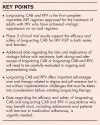A new paradigm for antiretroviral delivery: long-acting cabotegravir and rilpivirine for the treatment and prevention of HIV
- PMID: 34871188
- PMCID: PMC8694245
- DOI: 10.1097/COH.0000000000000708
A new paradigm for antiretroviral delivery: long-acting cabotegravir and rilpivirine for the treatment and prevention of HIV
Abstract
Purpose of review: Cabotegravir (CAB) and rilpivirine (RPV) is the first long-acting injectable antiretroviral therapy (ART) option approved for virologically suppressed adults with HIV-1. In addition, long-acting CAB is a promising agent for HIV preexposure prophylaxis (PrEP). This review focuses on phase 3 clinical trial results and implementation considerations for these long-acting ART and PrEP strategies.
Recent findings: Long-acting CAB and RPV administered every 4 weeks demonstrated noninferiority to oral ART through week 96 in both the ATLAS and FLAIR studies, whereas ATLAS-2M found similar efficacy through 96 weeks when the long-acting injectable ART was administered every 8 weeks instead of every 4 weeks. For prevention, two phase 3 trials were stopped early due to fewer incident HIV infections in participants receiving long-acting CAB every 8 weeks compared with daily oral tenofovir disoproxil fumarate-emtricitabine for PrEP. The long-acting therapies were well tolerated across all clinical trials.
Summary: Clinical trial results support the use of long-acting CAB for HIV PrEP and long-acting CAB and RPV as a switch strategy for adults with HIV-1 who are first virologically suppressed with oral ART. Implementation challenges persist, and data are urgently needed in populations who may benefit most from long-acting therapy, including adolescents, pregnant individuals, and those with barriers to medication adherence.
Copyright © 2021 The Author(s). Published by Wolters Kluwer Health, Inc.
Conflict of interest statement
References
-
- Panel on Antiretroviral Guidelines for Adults and Adolescents. Guidelines for the use of antiretroviral agents in adults and adolescents with HIV. Department of Health and Human Services. Available at: https://clinicalinfo.hiv.gov/sites/default/files/inline-files/AdultandAd.... [Accessed 7 October 2021].
-
- Scarsi KK, Swindells S. The promise of improved adherence with long-acting antiretroviral therapy: what are the data? J Int Assoc Provid AIDS Care 2021; 20:23259582211009011. - PMC - PubMed
-
This is a recent review of patient satisfaction, potential adherence benefits, as well as challenges related to long-acting therapy.
-
- Delany-Moretlwe S, Mullick S, Eakle R, Rees H. Planning for HIV preexposure prophylaxis introduction: lessons learned from contraception. Curr Opin HIV AIDS 2016; 11:87–93. - PubMed
-
- Viiv Healthcare ULC. Cabenuva® and Vocabria® [product monograph]. Laval, Quebec: Viiv Healthcare ULC; 2020.
-
- Viiv Healthcare. Cabenuva® prescribing information. Research Triangle Park, NC: Viiv Healthcare; 2021.
Publication types
MeSH terms
Substances
LinkOut - more resources
Full Text Sources
Medical
Research Materials
Miscellaneous


